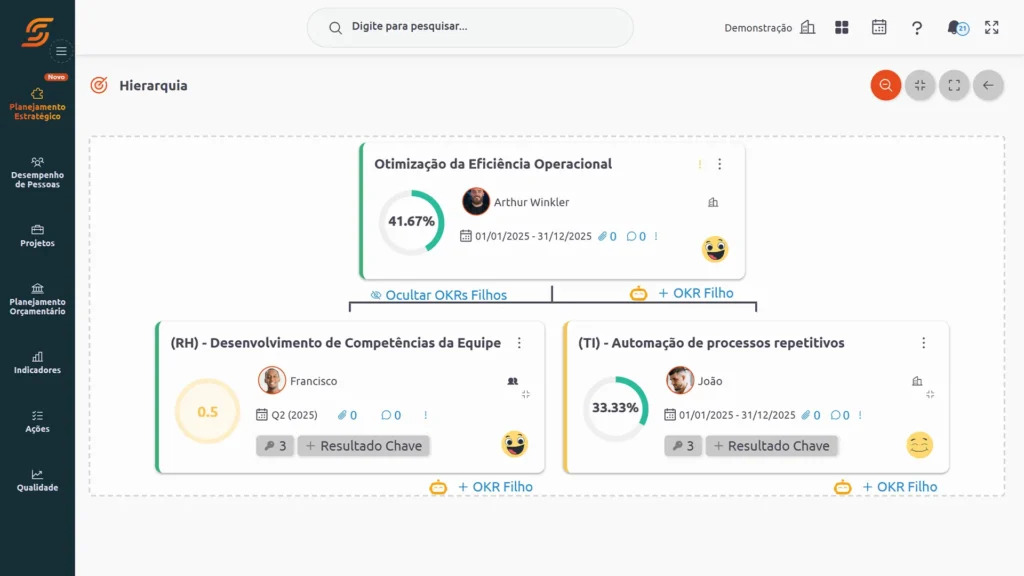Successful organizations have one thing in common: good strategic planning. After all, to achieve results and reach desired goals, it is necessary to define coherent strategies, align objectives, and structure viable action plans for the business.
And in this article, you will get to know the three levels of planning. They are: strategic, tactical, and operational.
We will define the purpose of each one, explain its importance, and show how large companies have benefited from their proper application, as well as addressing the most common errors associated with practices.
Also, we will understand how technologies and innovations impact the approach to strategic planning in companies. Enjoy your reading!
The three levels of planning

Strategic, tactical, and operational. These are the three levels of planning that work interdependently and harmoniously to ensure the success of the organization in the short, medium, and long term.
Briefly, we can think that the strategic level is responsible for the overall direction of the company, while the tactical level translates this direction into specific actions. The operational level, on the other hand, has the role of ensuring that daily activities are carried out efficiently.
When all levels are aligned, the company has more chances of achieving consistent results and a smooth workflow. To simplify the understanding of the concepts, how about getting to know the details and applications of each one?
Strategic planning
Strategic planning can be considered the highest level among the three, as it involves definitions that impact the company as a whole. Its main objective is to answer the questions: “where are we?” and “where do we want to go?”.
Therefore, it relates to the general guidelines of the organization, such as vision, mission, and long-term goals, as well as the key strategies to get there. Also, it is at the strategic level that we consider external and internal factors, such as market analysis, competition, available resources, and organizational competencies.
This type of planning foresees the direction that the company will follow for a long time, as well as guiding all decisions of leadership and its representatives during the period.
An example for you to better understand: a technology company identifies growth opportunities in the international market. So, it establishes as a vision “to become one of the leading brands of electronic devices in the world.” Thus, it defines long-term objectives, such as increasing market share and expanding operations to five new countries.
Tactical planning
Tactical planning relates to the implementation of everything that has been defined at the strategic level. In other words, this is where goals are transformed into concrete and executable actions.
Therefore, the main purpose of the tactical level is to answer the question: “how will we achieve our strategic objectives?”. For this, we establish medium-term action plans, identifying the necessary activities and assigning responsibilities to each department or team of the company.
It is the tactical level that will coordinate the different areas so that, together, they achieve the general directions of the company.
Example: with the strategic planning defined, the marketing department of the technology company develops a tactical plan to achieve international expansion. They identify target countries based on market research and develop specific strategies for each one. In parallel, the production department develops a tactical plan to increase production by 30%, ensuring that the company has the capacity to meet the growing demand in new markets.
Operational planning
Operational planning works on the daily activities of the organization and focuses on answering the question: “how will we execute our goals and tactical plans?”. Thus, it must respect and reflect the guidelines already established in the previous levels.
Its nature is short-term and provides practical instructions on how tasks should be performed. This includes defining deadlines, allocating resources, and monitoring the progress of each activity, in order to achieve efficiency and quality in operations.
In addition, the operational level involves solving day-to-day problems. Therefore, management must be prepared to deal with contingencies, make quick decisions, and ensure that operations continue.
Example: with tactical definitions, operational planning comes into play to ensure the execution of daily activities. The sales teams of the technology company begin to serve international customers, offering support and ensuring their satisfaction in purchases. In the production department, the team manages the growing demand. They monitor raw material stocks, monitor the efficiency of the assembly line, and implement continuous improvements in production processes.
Importance of planning levels
We have already seen that it is essential to align the 3 levels of planning, strategic, tactical, and operational, to make informed decisions. After all, each one fulfills its role to ensure actions aligned with organizational goals and foster the company’s growth.
The importance of the strategic level, for example, lies in offering a destination for the organization and avoiding it from becoming directionless or even stagnant. This way, it is possible to focus the team’s efforts, improve performance, and qualify the decisions made, in addition to adapting to changes in the business environment.
The relevance of tactical planning is in implementing, as best as possible, the pre-established strategies. This includes avoiding waste of resources, distributing responsibilities well, and ensuring alignment between teams.
Operational planning, in turn, keeps an eye on all the daily activities of the company. Therefore, its importance is much more practical, such as avoiding delays in production, excessive costs in operations, and dissatisfaction of customers.
Success stories with the 3 planning levels
Numerous prestigious organizations in the market successfully use planning at the strategic, tactical, and operational levels. One of the most well-known success stories, in fact, is that of the technology company Apple.
At the strategic level, Apple defined the vision of creating innovative products, combining elegant design and advanced features. At the tactical level, the company developed marketing strategies to position its products as objects of desire and established partnerships to ensure the availability of key components. At the operational level, the company focused on ensuring product quality and defining an efficient chain to meet global demand.
Another famous example is the McDonald’s network. At the strategic level, they set the goal of becoming the most recognized fast-food company in the world. At the tactical level, they implemented global expansion strategies, adapting their products and operations to meet different cultures and regional preferences. At the operational level, McDonald’s standardized processes, employee training, and quality controls, ensuring consistency of products and services in all its stores.
Most common mistakes
Regardless of the level approached, there are some myths when it comes to strategic planning. Therefore, it is essential to know the most common mistakes and avoid them, in order to ensure the efficiency of the concept in its application. Check it out!
Static strategic planning: one of the most common myths is to consider strategic planning as a single and unchangeable event. On the contrary, it is a continuous process that requires constant review and adaptations to changes in the business environment. Therefore, it is best to always be ready to adjust your strategies as new opportunities or threats arise.
Strategic planning only for management: strategic planning is not an exclusive responsibility of leadership. It must involve collaboration from different hierarchical levels and areas of the company. After all, everyone can contribute valuable ideas to the organization’s strategies.
Lack of alignment between levels: a very common mistake is the lack of alignment between tactical and strategic planning. Without this harmony, the company may face a lack of coordination in its actions, waste of resources, and lack of focus.
Lack of communication and information sharing: inadequate communication between teams can lead to failures in implementing tactical planning. Therefore, it is essential to communicate goals and objectives clearly to all involved. Furthermore, sharing relevant information is fundamental to ensure efficient and effective implementation.
Lack of monitoring and control: the operational level needs control to ensure well-executed daily activities. After all, without constant monitoring, it is more difficult to identify deviations, correct problems, and ensure the quality of operations. Key performance indicators can be excellent mechanisms to solve this problem.
Lack of flexibility and adaptation: another common mistake is not making operational planning flexible enough to deal with contingencies and changes. This lack of adaptation can lead to delays, quality issues, and missed opportunities. Therefore, companies must be prepared to adjust their operations according to market demands and conditions.
Impact of technology
Fortunately, the way strategic, tactical, and operational planning is done is undergoing transformations. The reason lies in the impact of technology, which is very positive for organizations seeking organic and continuous success.
With the help of the right software and technological solutions, it is possible to have real-time data and advanced analysis tools. Thus, the company can take advantage of valuable and precise insights about the market, its competitors, and the organization’s customers.
This facilitates the identification of opportunities and the formulation of strategies that are more coherent with the company’s reality. Furthermore, technology can simplify coordination and alignment between different planning levels.
Likewise, teams can share information more easily, collaborate remotely, and monitor plan progress in real-time. Technological adoption brings more agility to the company’s actions and increases its ability to adapt to market changes.




